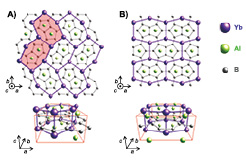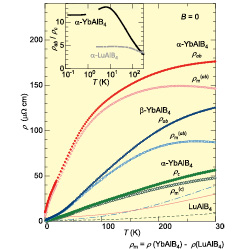Anisotropic Heavy-Fermi-Liquid Formation in Valence-Fluctuating α-YbAlB4
Nakatsuji Group
4f -based heavy-fermion (HF) systems have attracted much attention with interesting phenomena such as unconventional superconductivity and non-Fermi-liquid (NFL) behavior found in the vicinity of quantum critical points. Our recent studies have found the first Yb- (4f 13) based HF superconductivity with the transition temperature Tc = 80 mK in the compound β-YbAlB4 [1, 2]. Pronounced NFL behavior above Tc and its magnetic field dependence indicate that the system is a rare example of a pure metal that displays quantum criticality at ambient pressure and close to zero magnetic field [1]. Furthermore, the T/B scaling found in our recent high-precision magnetization measurements clarifies its unconventional zero-field quantum criticality without tuning [3], which cannot be explained by the standard theory based on spin-density-wave fluctuations. In contrast to the canonical quantum critical materials, hard x-ray photoemission spectroscopy (HXPES) measurements have revealed a strongly intermediate valence of Yb+2.75 [4], providing an example of quantum criticality in a mixed-valence system. Whether the valence fluctuation is relevant for the mechanism of quantum criticality and superconductivity is an interesting open question.

Fig. 1. Crystal structure of A) α-YbAlB4 and B) β-YbAlB4.

Fig. 2. Temperature dependence of the in-plane and c-axis resistivity ρab and ρc of α-YbAlB4 and ρab of β-YbAlB4. The magnetic part of the resistivity ρm is obtained by subtracting the nonmagnetic contribution estimated by ρab of α- and β-LuAlB4 (solid and dash-dotted lines, respectively) or ρc of α-LuAlB4 (dashed line). The inset shows the temperature dependence of the ratios ρab/ρc for α-YbAlB4 and α-LuAlB4.
Here, we measured the specific heat, magnetization, and resistivity of α-YbAlB4 down to very low temperature [5]. This compound is the locally isostructural polymorph of β-YbAlB4 with a different arrangement of distorted hexagons made of Yb atoms [space groups Pbam(α-YbAlB4) and Cmmm(β-YbAlB4), see Fig. 1]. According to the HXPES measurement [4], α-YbAlB4 also has an intermediate valence of Yb+2.73. The results indicate a Fermi-liquid (FL) ground state for α-YbAlB4 in contrast to the unconventional quantum criticality observed in β-YbAlB4. Interestingly, both systems exhibit Kondo lattice behavior with a small renormalized temperature scale of T* ∼ 8 K, although both of them have a large valence-fluctuation scale of ∼200 K. Below T*, α-YbAlB4 forms a heavy-Fermi-liquid state with an electronic specific heat coefficient γ ∼ 130 mJ/mol K2 and a large Wilson ratio greater than 7, which indicates a ferromagnetic correlation between Yb moments. A Kadowaki- Woods ratio is found that is similar to those found in the normal Kondo lattice systems and considerably larger than mixed valence systems. Furthermore, the resistivity of α-YbAlB4 exhibits one of the strongest anisotropies in heavy fermions (Fig. 2). The ratio between in plane and c-axis resistivity ρab and ρc, ρab/ρc, reaches 11 at low temperatures below T*. This strongly suggests anisotropic hybridization between 4f and conduction electrons which is stronger in the ab-plane. This is the key to understanding the mechanism of heavy-fermion formation as well as the Kondo lattice behavior found in the intermediate-valence system. Thus the system should be one of the best systems to study for elucidating the effects of anisotropic hybridization.
References
- [1] S. Nakatsuji, K. Kuga, Y. Machida, T. Tayama, T. Sakakibara, Y. Karaki, H. Ishimoto, S. Yonezawa, Y. Maeno, E. Pearson, G. G. Lonzarich, L. Balicas, H. Lee, and Z. Fisk, Nature Physics 4, 603 (2008).
- [2] K. Kuga, Y. Karaki, Y. Matsumoto, Y. Machida, and S. Nakatsuji, Phys. Rev. Lett. 101, 137004 (2008).
- [3] Y. Matsumoto, S. Nakatsuji, K. Kuga, Y. Karaki, N. Horie, Y. Shimura, T. Sakakibara, A. H. Nevidomskyy, and P. Coleman, Science 331, 316 (2011).
- [4] M. Okawa, M. Matsunami, K. Ishizaka, R. Eguchi, M. Taguchi, A. Chainani, Y. Takata, M. Yabashi, K. Tamasaku, Y. Nishino, T. Ishikawa, K. Kuga, N. Horie, S. Nakatsuji, and S. Shin, Phys. Rev. Lett. 104, 247201 (2010).
- [5] Y. Matsumoto, K. Kuga, T. Tomita, Y. Karaki, and S. Nakatsuji, Phys. Rev. B 84, 125126 (2011).
